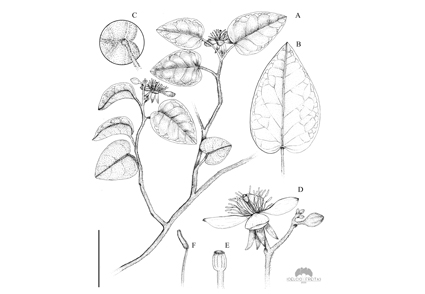Abstract
Mesocapparis minutiflora, a new species for the Cerrado, is described and compared with related species. The taxon is described from the state of Tocantins and Piauí, with only five known collections. It is distinguished from other species mainly by the different shapes of leaf base, petiolar insertion, and the shorter size of petals, gynophore, and filaments. The conservation status of the new species is discussed, and information is provided on its flowering period and geographic distribution.
References
- Cornejo, X. & Iltis, H.H. (2008) Two new genera of Capparaceae: Sarcotoxicum and Mesocapparis stat. nov., and the reinstatement of Neocalyptrocalyx. Harvard Papers in Botany 13: 109–113. https://doi.org/10.3100/1043-4534(2008)13[103:TNGOCS]2.0.CO;2
- Dombey, J. & Persoon, C.H. (1807) Synopsis Plantarum. Vol. 2. Novon, pp. 60.
- Eichler, A.W. (1865) Capparideae. In: Martius, C.F.P. & Eichler, A.G. (Eds.) Flora brasiliensis. Vol. 13, part 1. R. Oldenbourg, Munich and Leipzig, pp. 237–292.
- IPNI (2023) International Plant Names Index. The Royal Botanic Gardens, Kew, Harvard University Herbaria & Libraries and Australian National Herbarium. Published on the Internet: http://www.ipni.org (accessed: 25 July 2023).
- IUCN (2017) Guidelines for using the IUCN Red List Categories and Criteria. Version 12. Prepared by the Standards and Petitions Subcommittee, 101 pp. Available from: http://www.iucnredlist.org/documents/RedListGuidelines.pdf (accessed: 28 February 2024).
- Pax, F. & Hoffman, K. (1936) Capparidaceae. In: Engler, A. & Prantl, K. (Eds.) Die Naturlichen Pflanzenfamilien. 2a ed. Vol. 17b. Engelmann, Leipzig, pp. 146–158.
- Su, J.X., Wang, W., Zhang, L.B. & Chen, Z.D. (2012) Phylogenetic placement of two enigmatic genera, Borthwickia and Stixis, based on molecular and pollen data, and the description of a new family of Brassicales, Borthwickiaceae. Taxon 61 (3): 601–611. https://doi.org/10.1002/tax.613009
- Thiers, B. (2019) [continuously updated] Index herbariorium: A global directory of publish herbaria and associated staff. New York Botanical Garden’s Virtual Herbarium. Available from: http://sciweb.nybg.org/science2/IndexHerbariorum.asp (accessed: 28 October 2022).


